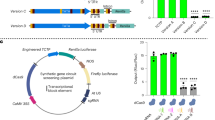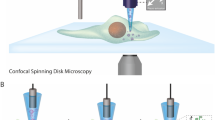Abstract
The stable integration of transgenes into embryos of the frog Xenopus laevis is achieved using the procedure described here. Linear DNA containing the transgene is incorporated randomly into sperm nuclei that have had their membranes disrupted with detergent treatment. Microinjection of these nuclei into unfertilized eggs produces viable embryos that can be screened for activity of the transgene. The proportion of embryos that harbor the transgene varies from 10 to 40% of the total number of surviving embryos. Multiple copies of the transgene can integrate as a concatemer into the sperm genome, and more than one site of DNA integration might occur within resulting animals. Germ cell transmission of the transgene is routine and the procedure is well suited to the production of transgenic reporter frog lines. One day should be allocated for the preparation of the sperm nuclei, which are stored as aliquots for future use. The transgenesis reaction and egg injection take one morning.
This is a preview of subscription content, access via your institution
Access options
Subscribe to this journal
Receive 12 print issues and online access
$259.00 per year
only $21.58 per issue
Buy this article
- Purchase on Springer Link
- Instant access to full article PDF
Prices may be subject to local taxes which are calculated during checkout





Similar content being viewed by others
References
Kroll, K.L. & Amaya, E. Transgenic Xenopus embryos from sperm nuclear transplantations reveal FGF signaling requirements during gastrulation. Development 122, 3173–3183 (1996).
Sive, H.L., Grainger, R.M. & Harland, R.M. Early development of Xenopus laevis. A laboratory manual (Cold Spring Harbor Laboratory Press, Cold Spring Harbor, New York, 2000).
Sparrow, D.B., Latinkic, B. & Mohun, T.J. A simplified method of generating transgenic Xenopus. Nucleic Acids Res. 28, E12 (2000).
Allen, B.G. & Weeks, D.L. Transgenic Xenopus laevis embryos can be generated using phiC31 integrase. Nat. Methods 2, 975–979 (2005).
Allen, B.G. & Weeks, D.L. Using phiC31 integrase to create transgenic Xenopus laevis. Nature Protocols 1 (3): 1247–1257 (2006).
Pan, F.C., Chen, Y., Loeber, J., Henningfeld, K. & Pieler, T. I-SceI meganuclease-mediated transgenesis in Xenopus. Dev. Dyn. 235, 247–252 (2006).
Ogino, H., McConnell, W.B. & Grainger, R.M. Highly efficient transgenesis in Xenopus tropicalis using I-SceI meganuclease. Mech. Dev. 123, 103–113 (2006).
Hajime, O., McConnell, W.B. & Grainger, R.M. High-throughput transgenesis in xenopus using I-Sce1 meganuclease. Nat. Protoc. (doi: 10.1038/nprot.2006.208).
Smith, S.J. & Mohun, T.J. Frog transgenesis made simple. Nat. Methods 2, 897–898 (2005).
Latinkic, B.V. et al. Distinct enhancers regulate skeletal and cardiac muscle-specific expression programs of the cardiac alpha-actin gene in Xenopus embryos. Dev. Biol. 245, 57–70 (2002).
Latinkic, B.V. et al. Transcriptional regulation of the cardiac-specific MLC2 gene during Xenopus embryonic development. Development 131, 669–679 (2004).
Karaulanov, E., Knochel, W. & Niehrs, C. Transcriptional regulation of BMP4 synexpression in transgenic Xenopus. Embo. J. 23, 844–856 (2004).
Allende, M.L., Manzanares, M., Tena, J.J., Feijoo, C.G. & Gomez-Skarmeta, J.L. Cracking the genome's second code: enhancer detection by combined phylogenetic footprinting and transgenic fish and frog embryos. Methods 39, 212–219 (2006).
Sparrow, D.B. et al. Regulation of the tinman homologues in Xenopus embryos. Dev. Biol. 227, 65–79 (2000).
Smith, S.J., Kotecha, S., Towers, N., Latinkic, B.V. & Mohun, T.J. XPOX2-peroxidase expression and the XLURP-1 promoter reveal the site of embryonic myeloid cell development in Xenopus. Mech. Dev. 117, 173–186 (2002).
Smith, S.J. et al. The MLC1v gene provides a transgenic marker of myocardium formation within developing chambers of the Xenopus heart. Dev. Dyn. 232, 1003–1012 (2005).
Breckenridge, R.A., Mohun, T.J. & Amaya, E. A role for BMP signalling in heart looping morphogenesis in Xenopus. Dev. Biol. 232, 191–203 (2001).
Brown, D.D. et al. Thyroid hormone controls multiple independent programs required for limb development in Xenopus laevis metamorphosis. Proc. Natl. Acad. Sci. USA 102, 12455–12458 (2005).
Gilchrist, M.J. et al. Defining a large set of full-length clones from a Xenopus tropicalis EST project. Dev. Biol. 271, 498–516 (2004).
Du Pasquier, D. et al. Survivin increased vascular development during Xenopus ontogenesis. Differentiation 74, 244–253 (2006).
Li, M. & Rohrer, B. Gene silencing in Xenopus laevis by DNA vector-based RNA interference and transgenesis. Cell Res. 16, 99–105 (2006).
Chae, J., Zimmerman, L.B. & Grainger, R.M. Inducible control of tissue-specific transgene expression in Xenopus tropicalis transgenic lines. Mech. Dev. 117, 235–241 (2002).
Ryffel, G.U. et al. Tagging muscle cell lineages in development and tail regeneration using Cre recombinase in transgenic Xenopus. Nucleic Acids Res. 31, e44 (2003).
Bronchain, O.J., Hartley, K.O. & Amaya, E. A gene trap approach in Xenopus. Curr. Biol. 9, 1195–1198 (1999).
Huang, H., Marsh-Armstrong, N. & Brown, D.D. Metamorphosis is inhibited in transgenic Xenopus laevis tadpoles that overexpress type III deiodinase. Proc. Natl. Acad. Sci. USA 96, 962–967 (1999).
Author information
Authors and Affiliations
Corresponding author
Ethics declarations
Competing interests
The authors declare no competing financial interests.
Supplementary information
Supplementary Video 1
Procedure to fill an injection needle (step 30) (MOV 9556 kb)
Supplementary Video 2
Injection technique (MOV 9609 kb)
Rights and permissions
About this article
Cite this article
Smith, S., Fairclough, L., Latinkic, B. et al. Xenopus laevis transgenesis by sperm nuclear injection. Nat Protoc 1, 2195–2203 (2006). https://doi.org/10.1038/nprot.2006.325
Published:
Issue Date:
DOI: https://doi.org/10.1038/nprot.2006.325
This article is cited by
-
Epigenetic homogeneity in histone methylation underlies sperm programming for embryonic transcription
Nature Communications (2020)
-
Histone H3 lysine 9 trimethylation is required for suppressing the expression of an embryonically activated retrotransposon in Xenopus laevis
Scientific Reports (2015)
-
Skeletal muscle regeneration in Xenopus tadpoles and zebrafish larvae
BMC Developmental Biology (2012)
-
“Transgenesis, recent technical developments and applications” Nantes, 8th June 2009
Transgenic Research (2010)
Comments
By submitting a comment you agree to abide by our Terms and Community Guidelines. If you find something abusive or that does not comply with our terms or guidelines please flag it as inappropriate.



